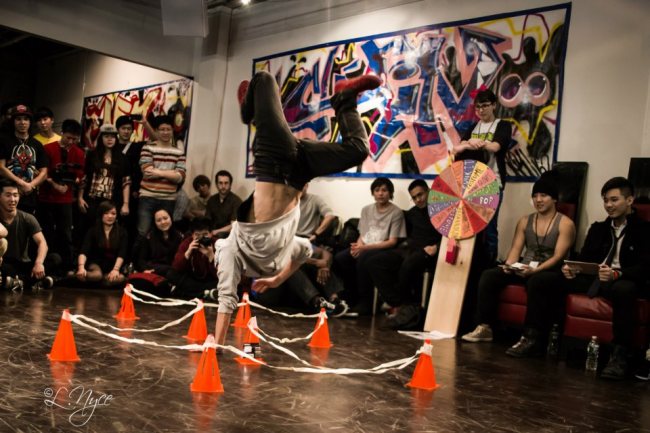Breaking the Rules: Game Mechanics as Pathway to Culture

At a breakdance competition, the crowd knows more than you. Sure, it may seem obviously impressive when a dancer spins on his head and freezes in an upside-down pose, but unless you’re a dancer yourself, the crowd will seem to roar and dim at random, prompted by minute changes in footwork or imperceptible mistakes. As an outsider, you squint at the combatants for signs, any sign, of how you should react.
And then the challenger steps into a tutu and you’re pretty sure this is where you laugh.
At Unlucky Breaks, breakdancers do battle at the whim of the Wheel of Misfortune, a game show-esque wheel spun before every match-up. Should it land on “Costume”? Strap on your tutu and matching pink bow. Land on “Amputee”? Pick one limb and dance without using it. Each modifier throws a random wrinkle into the battle, adding another level of challenge to an already physically-demanding improvisational dance form.
If it all sounds suspiciously gamey, that’s not a coincidence – breakdancer/organizers Eddie Yoo and Katya Hott are also game producers in NYC’s close-knit game industry. Seeing an opportunity in the city’s dance scene, they decided to leverage game mechanics to share their love of breakdancing with a larger audience (as well as embarrass friends via tutu).
“When I first started breaking, one of the first things I was told was ‘you have to be aggressive, you have to be in their face, you have to never smile in a battle because this guy’s your opponent,’” says Yoo. But as the hardcore stylings of the South Bronx, where breaking was born, gave way to a more inclusive global dance scene, the opportunity to add some fun wrinkles to the format seemed too good to pass up.

But the addition of the wheel adds more than just novelty and an excuse from b-boy posturing. By adding easily-understood restrictions, the barriers to being a literate spectator drop considerably. The thrill of the next unknown challenge to come and if the next contender will be able to meet it, let alone out-dance his opponent, adds another level of dramatic tension that unifies the crowd. And, by making it easier to appreciate what’s happening, spectators who wouldn’t know a toprock from Pop Rocks find themselves engrossed in a subculture they may never have bothered to explore.
The Neat Thing about Football
The use of game design concepts to make cultural activities more accessible is nothing new, but as a practice it remains underused. As opposed to the zeitgeisty nomenclature of gamification, where the focus is on applying game mechanics and tropes (usually extrinsic rewards and progress indicators) to shape desired behavior, think instead of the booming popularity of Fantasy Football.
Say you never really cared for the sport. By adding a meta-layer of strategy and personal investment, suddenly football becomes an incredibly compelling thing to watch – all because of the additional meaning you take away from each game. The beautiful part is, now you can sit next to a die-hard fan at the bar and, on a meaningful level, appreciate the same exact game.
Now pare it down to extremes. Say some professional-caliber athletes decided to host a pick-up game at a park, way before the NFL entered the picture. Passersby might watch for a while, but aren’t likely to stick around too long.
But what if each team had a name, and represented a district? And what if this game wasn’t some pick-up game, but decided the champion of the park? Add in drafts and trades, and suddenly a pick-up game becomes something that even spectators – who may never have played themselves – can feel a genuine connection to, with a feeling of community among fellow spectators and a sense of solidarity with the athletes. It’s something achieved by every major sport in existence, yet the power of harnessing game mechanics for this purpose outside of sports goes under-utilized the world over.
The Risk of New Things
Remember the last time you went to a cultural event you had never experienced? Do you remember the slightly queasy mixture of anticipation and dread as you entered the building, hoping that, whatever this thing was, it wouldn’t be as boring as you thought it might be?
Regardless if you were dragged along or ventured out to try something new, the sense of confusion, that you don’t belong here, is mainly due to your not having a baseline expectation for what you are about to experience. That lack of data registers as risk in your animal brain, and the desire to not experience this unpleasant feeling is what deters most from trying new things as often as they’d like.
So how do you overcome this barrier to new cultural experiences? You mitigate the risk by adding easily understood dramatic tension. Elements like chance, obstacles, rewards, and easily told self-contained narratives offer a familiar framework when being introduced to an entirely new subculture. Suddenly, you’ll find people addicted to watching trivia contests (Jeopardy), cooking (Top Chef), no-name singers (American Idol) and garage sales (Antiques Roadshow). They’re called game shows for good reason.

Maybe the TV industry figured this out long ago. But there’s a piece to this puzzle that is still far from solved. Every example mentioned so far of utilizing game structures to increase accessibility to cultural experiences applies only to competitive experiences, or to solitary experiences framed in competition. What about non-interactive, one-way experiences, like reading a novel, watching a ballet performance, trying a new cuisine? Surely there’s a way to utilize the power of game mechanics to make them more accessible, too?
If there is, it remains elusive. And it sure doesn’t lie in dangling extrinsic rewards that do more harm than good in fostering an interest in the cultural offerings of the world (“You earned the ‘Walk around a Museum for 4 Hours’ Badge!”).
Like the fantasy football player who watches the game intently, only by fusing the game aspect with the intrinsic experience of actually caring about the thing do you begin to foster meaningful appreciation. And when it comes to exploring the vast cultural offerings of the world, I’d take real appreciation over experience points every time.
